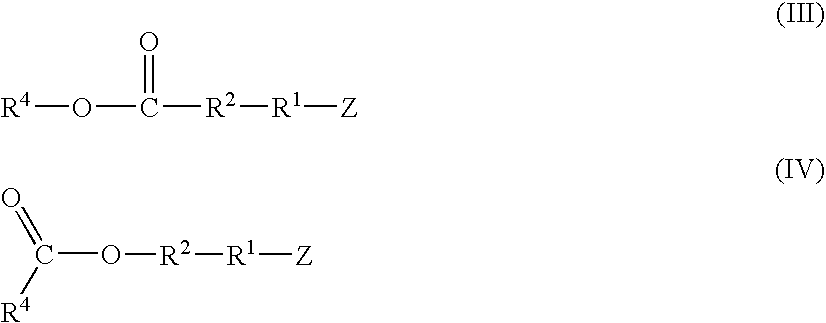Functionalized high cis-1,4-polybutadiene prepared using novel functionalizing agents
a polybutadiene and high cis technology, applied in the field of functionalizing agents, can solve the problems of difficult to obtain the reaction conditions required to achieve functionalization, limited ability of coordination catalysis to functionalize the resulting polymer, and inability to obtain high cis polymers. achieve the effect of high cis microstructur
- Summary
- Abstract
- Description
- Claims
- Application Information
AI Technical Summary
Benefits of technology
Problems solved by technology
Method used
Image
Examples
examples 1-4
[0059] A catalyst was prepared by mixing 0.5 g of 1,3-butadiene monomer in hexanes, 0.32 mmol of neodymium neodecanoate in hexanes, 31.7 mmol of methylaluminoxane in toluene, and 6.67 mmol of diisobutylaluminum hydride in hexanes within a dried and N2 purged bottle equipped with a rubber septum. After two minutes of contact, 1.27 mmol of diethylaluminum chloride in hexanes was added to the mixture. The mixture was then aged at room temperature for about 15 minutes.
[0060] Polybutadiene polymer was prepared by mixing the catalyst solution prepared above with 611 g of 1,3-butadiene monomer in about 3,459 g of hexanes at 25° C. within a two-gallon stainless steel reactor equipped with an agitator and a jacket for temperature control. This mixture was agitated for about 10 minutes at 24° C. The jacket temperature was increased to 72° C. and agitation continued for 33 minutes, after which the jacket temperature was lowered to 70° C. The polymer cement was sampled into separate dried and ...
examples 5-7
[0064] A catalyst was prepared by mixing 0.5 g of 1,3-butadiene monomer in hexanes, 0.275 mmol of neodymium neodecanoate in hexanes, 27.5 mmol of methylaluminoxane in toluene, and 5.77 mmol of diisobutylaluminum hydride in hexanes within a dried and N2 purged bottle equipped with a rubber septum. After two minutes of contact, 1.10 mmol of diethylaluminum chloride in hexanes was added to the mixture. The mixture was then aged at room temperature for about 15 minutes.
[0065] Polybutadiene polymer was prepared as in Examples 1-4, except that the jacket temperature was initially set at 26° C., and was increased to 82° C. The polymer cement was sampled into separate dried and N2-purged bottles and identified as Examples 5-7. Examples 6 and 7 were functionalized with DEAB, which was charged to the bottles in toluene solution, as set forth in Table I. Comparative Example 5 was not functionalized with DEAB.
examples 8-10
[0066] A catalyst was prepared by mixing 0.5 g of 1,3-butadiene monomer in hexanes, 0.317 mmol of neodymium neodecanoate in hexanes, 31.7 mmol of methylaluminoxane in toluene, and 6.67 mmol of diisobutylaluminum hydride in hexanes within a dried and N2 purged bottle equipped with a rubber septum. After two minutes of contact, 1.27 mmol of diethylaluminum chloride in hexanes was added to the mixture. The mixture was then aged at room temperature for about 15 minutes.
[0067] Polybutadiene polymer was prepared as in Examples 1-4, except that the jacket temperature was initially set at 27° C., and was increased to 82° C. The polymer cement was sampled into separate dried and N2-purged bottles and identified as Examples 8-10. Examples 9 and 10 were functionalized with DMI, which was charged to the bottles in neat form, as set forth in Table I. Comparative Example 8 was not functionalized with DMI.
TABLE I12345678910Functionalizing AgentNoneDEABDEABNoneNoneDEABDEABNoneDMIDMIAmount of fun...
PUM
| Property | Measurement | Unit |
|---|---|---|
| molecular weight distribution | aaaaa | aaaaa |
| molecular weight distribution | aaaaa | aaaaa |
| molecular weight distribution | aaaaa | aaaaa |
Abstract
Description
Claims
Application Information
 Login to View More
Login to View More - R&D
- Intellectual Property
- Life Sciences
- Materials
- Tech Scout
- Unparalleled Data Quality
- Higher Quality Content
- 60% Fewer Hallucinations
Browse by: Latest US Patents, China's latest patents, Technical Efficacy Thesaurus, Application Domain, Technology Topic, Popular Technical Reports.
© 2025 PatSnap. All rights reserved.Legal|Privacy policy|Modern Slavery Act Transparency Statement|Sitemap|About US| Contact US: help@patsnap.com



